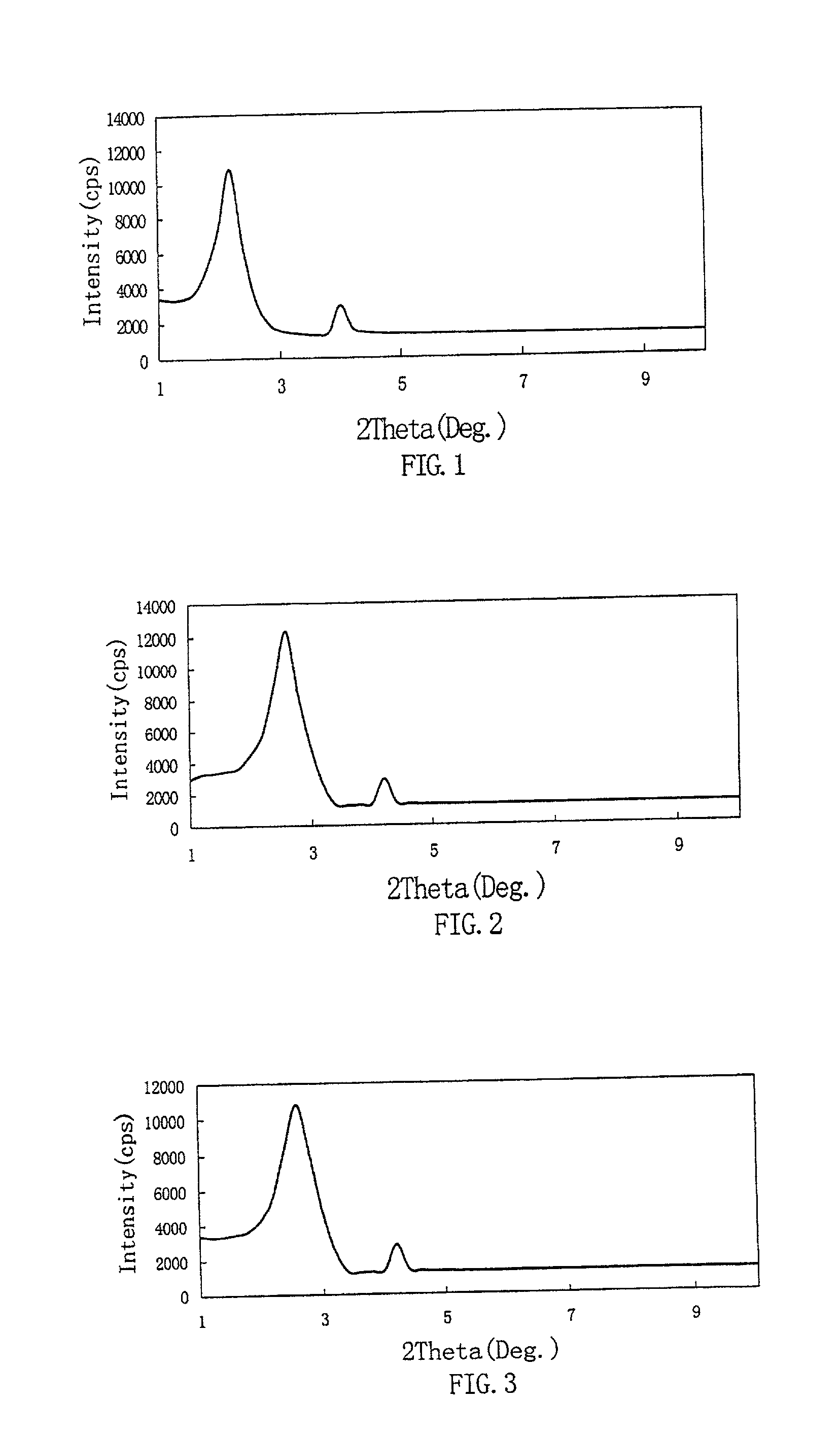Mesoporous molecular sieve and a process for the preparation of the same
a technology of molecular sieve and membrane, which is applied in the field of molecular sieve, can solve the problems of poor hydrothermal stability, difficult for them to have any value for practical applications, and difficult to achieve the effect of substantive solution of thermal stability and hydrothermal stability problems, etc., and achieves high thermal and hydrothermal stability, the effect of large specific surface and adsorption capacity
- Summary
- Abstract
- Description
- Claims
- Application Information
AI Technical Summary
Benefits of technology
Problems solved by technology
Method used
Image
Examples
example 2
[0040] 23 g of 85 wt % orthophosphoric acid was mixed with 50 g of deionized water, then 34.2 g of Al.sub.2(SO.sub.4).sub.3 was added. The mixture was heated to 45.degree. C. on a water-bath. After mixing to make it uniform, 5.4 g of phenethoxy-2-hydroxypropyltrimethylammonium chloride (PTMAC) and 40 g deionized water were added and stirred thoroughly. The pH value of the reaction mixture was adjusted with triethyl amine to 6.5 to yield a mixture, the mole composition of which was:
P.sub.2O.sub.5 / Al.sub.2O.sub.3=1.0
H.sub.2O / Al.sub.2O.sub.3=50
R / Al.sub.2O.sub.3=0.2
[0041] The above mixture was transferred to an autoclave pressure lined with Teflon inside, and statically crystallized at 160.degree. C. for 60 h. The solid obtained after filtering the reaction product was washed with water thoroughly, dried at 110.degree. C. for 4 h, and then measured by X-ray diffraction. The result exhibits a strong peak at 2.theta.=2.101, and the units d-spacing d=4.24724 nm. This result demonstrates th...
example 3
[0043] 34.5 g of 85 wt % orthophosphoric acid was mixed with 50 g of deionized water, then 14.2 g of pseudo-diaspore containing 28 wt % water was added. The mixture was heated to 50.degree. C. on a water-bath. After mixing to make it uniform, 54.4 g of phenethoxy-2-hydroxypropyltrimethyla- mmonium chloride (PTMAC) and 140 g deionized water were added and the mixture was stirred thoroughly. The pH value of the reaction mixture was adjusted with sodium hydroxide to 6.0 to yield a mixture, the mole composition of which was:
P.sub.2O.sub.5 / Al.sub.2O.sub.3=1.5
H.sub.2O / Al.sub.2O.sub.3=100
R / Al.sub.2O.sub.3=2.0
[0044] The crystallization conditions are shown in Table 1, the properties of the product are shown in Table 2, and the anhydrous mole composition was:
P.sub.2O.sub.5 / Al.sub.2O.sub.3=0.98.
example 4
[0045] 16.1 g of 85 wt % orthophosphoric acid was mixed with 120 g of deionized water, then 40.8 g of aluminum isopropoxide was added. The mixture was heated to 30.degree. C. on a water-bath. After mixing to make it uniform, 27.2 g of phenethoxy-2-hydroxypropyltrimethylammonium chloride (PTMAC) and 600 g deionized water were added and the mixture was stirred thoroughly. The pH value of the reaction mixture was adjusted with aqueous ammonia to 11.0 to yield a mixture, the mole composition of which was:
P.sub.2O.sub.5 / Al.sub.2O.sub.3=0.7
H.sub.2O / Al.sub.2O.sub.3=400
R / Al.sub.2O.sub.3=1.0
[0046] The crystallization conditions are shown in Table 1, the properties of the product are shown in Table 2, and the anhydrous mole composition was:
P.sub.2O.sub.5 / Al.sub.2O.sub.3=0.97.
PUM
| Property | Measurement | Unit |
|---|---|---|
| Time | aaaaa | aaaaa |
| Time | aaaaa | aaaaa |
| Time | aaaaa | aaaaa |
Abstract
Description
Claims
Application Information
 Login to View More
Login to View More - R&D
- Intellectual Property
- Life Sciences
- Materials
- Tech Scout
- Unparalleled Data Quality
- Higher Quality Content
- 60% Fewer Hallucinations
Browse by: Latest US Patents, China's latest patents, Technical Efficacy Thesaurus, Application Domain, Technology Topic, Popular Technical Reports.
© 2025 PatSnap. All rights reserved.Legal|Privacy policy|Modern Slavery Act Transparency Statement|Sitemap|About US| Contact US: help@patsnap.com

